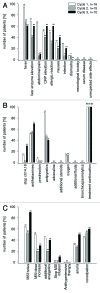Ch14.18 antibody produced in CHO cells in relapsed or refractory Stage 4 neuroblastoma patients: a SIOPEN Phase 1 study
- PMID: 23924804
- PMCID: PMC3851232
- DOI: 10.4161/mabs.25215
Ch14.18 antibody produced in CHO cells in relapsed or refractory Stage 4 neuroblastoma patients: a SIOPEN Phase 1 study
Abstract
Purpose: This study aimed to assess the safety, pharmacokinetic and activity profiles of the human-mouse chimeric monoclonal anti-disialoganglioside GD2 antibody ch14.18 produced in Chinese hamster ovary (CHO) cells (ch14.18/CHO).
Methods: Sixteen children with recurrent/refractory neuroblastoma (median age 7.6 y) were enrolled in this Phase 1 dose-finding study. Patients received ch14.18/CHO courses of 10, 20 or 30 mg/m (2)/day as an eight-hour infusion over five consecutive days. Three courses at the same dose level were allowed unless disease progressed. Clearance and biodistribution of radiolabelled ch14.18/CHO in Balb/c and A/J mice were analyzed.
Results: A total of 41 ch14.18/CHO courses were given (10 × 3 courses, 5 × 2 courses, 1 × 1 course). Side effects were similar in expectedness, frequency and magnitude to those reported for ch14.18/SP2/0. The dose level of 20 mg/m(2)/day was confirmed. Toxicity was reversible and no treatment-related deaths occurred. In children, the peak plasma concentration was 16.51 µg/ml ± 5.9 µg/ml and the half-life was 76.91 h ± 52.5 h. A partial response following ch14.18/CHO was observed in 2/7 patients with residual disease. In mice, the half-lives were 22.7 h ± 1.9h for ch14.18/CHO and 25.0 h ± 1.9 h for ch14.18/SP2/0. The biodistribution of (125)I-ch14.18/CHO in mice with neuroblastoma was identical to (125)I-ch14.18/SP2/0, indicating GD 2 targeting activity in vivo. Ch14.18 produced in CHO cells showed an unchanged toxicity profile and pharmacokinetics in neuroblastoma patients compared with ch14.18 produced in SP2/0 cells, and evidence of clinical activity was observed. In mice, analysis of pharmacokinetics and biodistribution showed comparable results between ch14.18/CHO and ch14.18/SP2/0. Based on these results, ch14.18/CHO was accepted for prospective clinical evaluation.
Keywords: anti GD2; ch14.18/CHO; immunotherapy; monoclonal antibody; neuroblastoma.
Figures


References
-
- Ladenstein R, Pötschger U, Siabalis D, Garaventa A, Bergeron C, Lewis IJ, et al. Dose finding study for the use of subcutaneous recombinant interleukin-2 to augment natural killer cell numbers in an outpatient setting for stage 4 neuroblastoma after megatherapy and autologous stem-cell reinfusion. J Clin Oncol. 2011;29:441–8. doi: 10.1200/JCO.2009.23.5465. - DOI - PubMed
-
- Matthay KK, Villablanca JG, Seeger RC, Stram DO, Harris RE, Ramsay NK, et al. Children’s Cancer Group Treatment of high-risk neuroblastoma with intensive chemotherapy, radiotherapy, autologous bone marrow transplantation, and 13-cis-retinoic acid. N Engl J Med. 1999;341:1165–73. doi: 10.1056/NEJM199910143411601. - DOI - PubMed
Publication types
MeSH terms
Substances
LinkOut - more resources
Full Text Sources
Other Literature Sources
Medical
